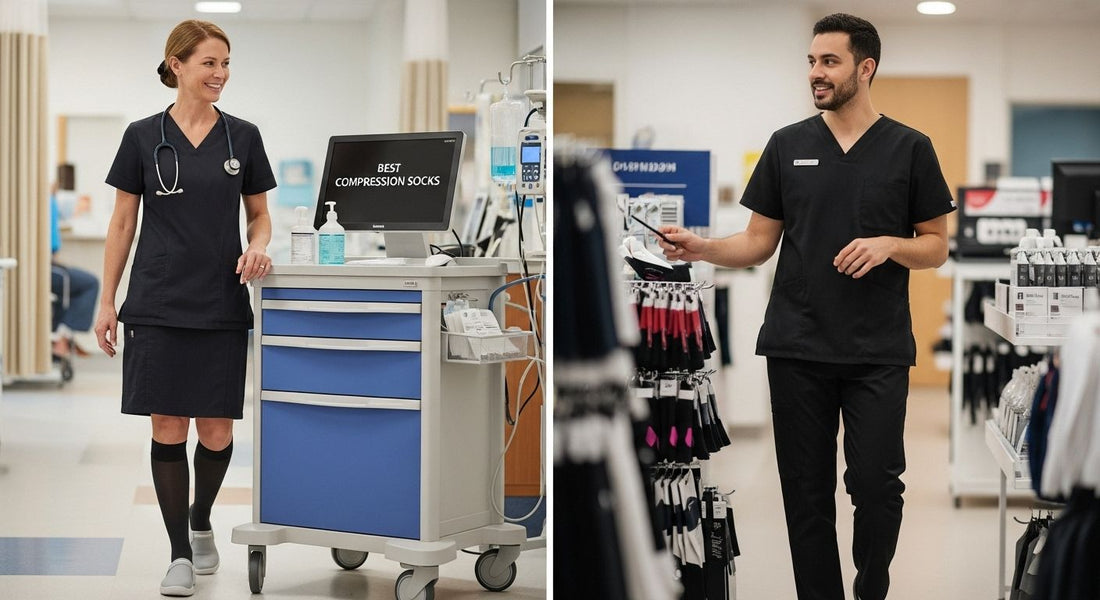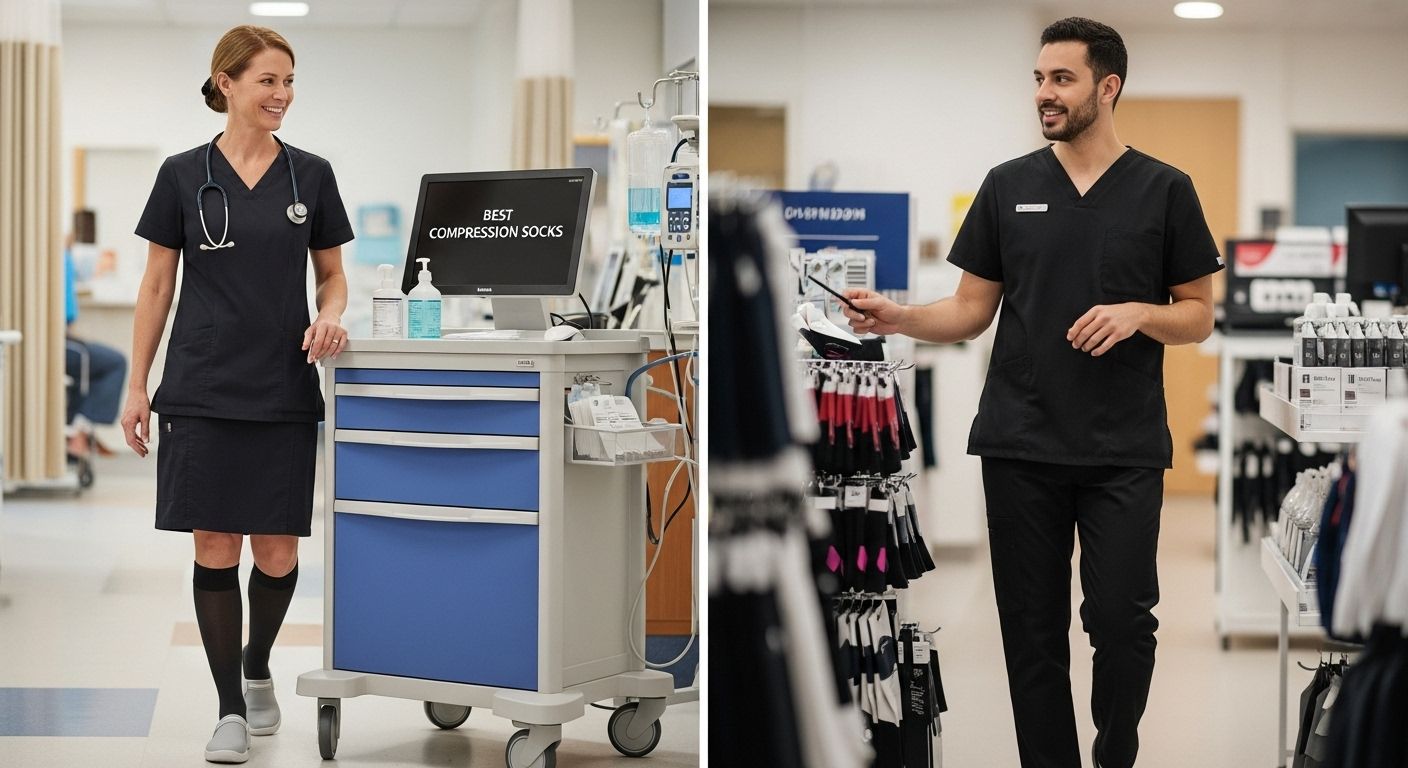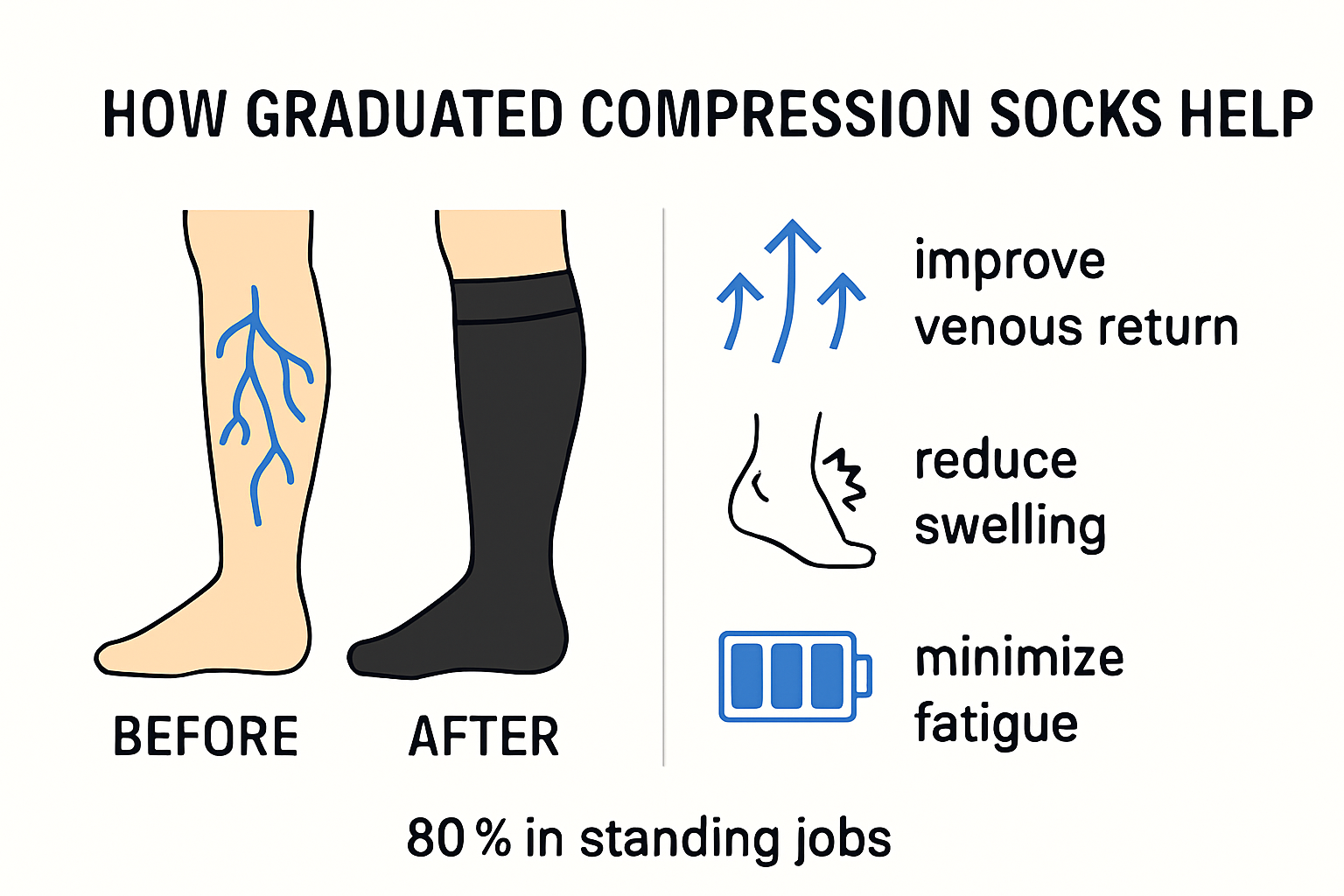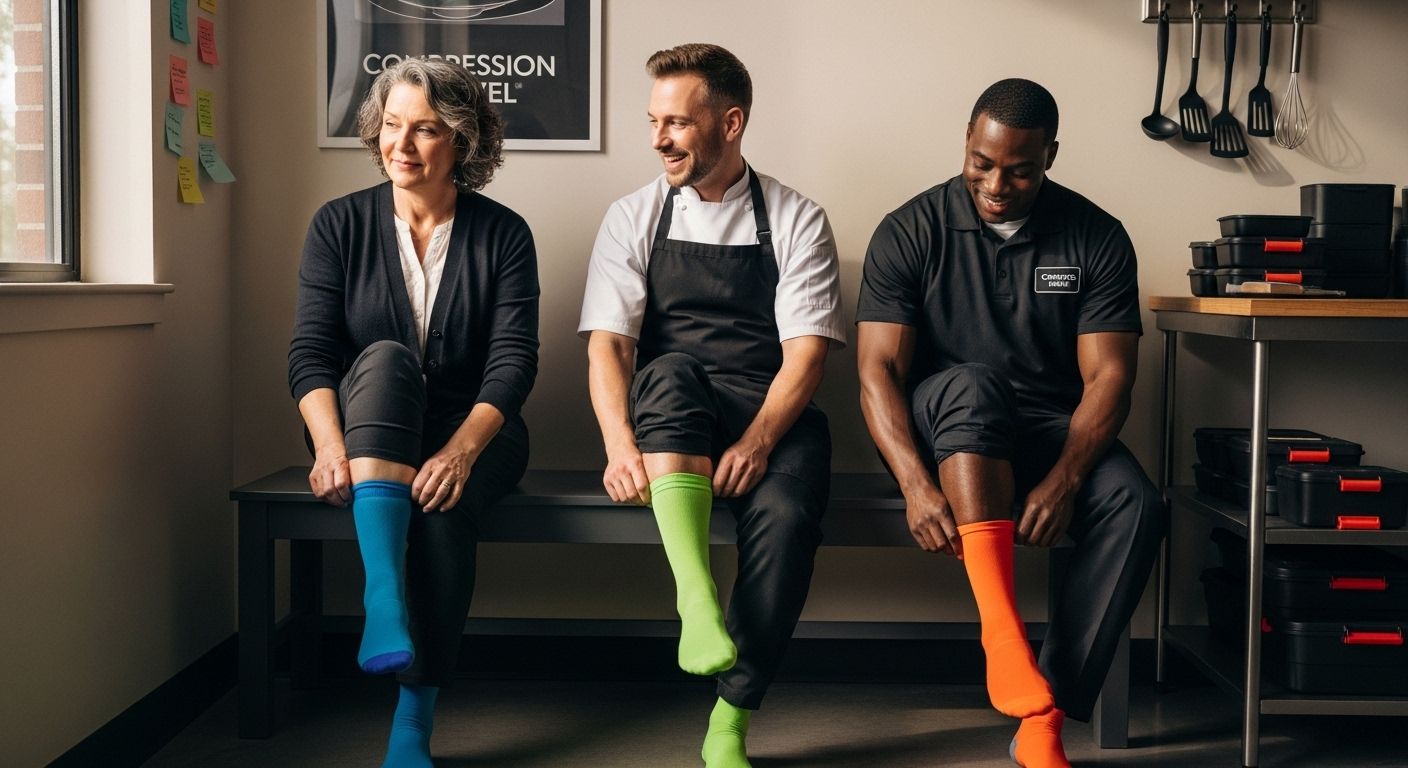
Best Compression Socks for Standing Jobs in 2025
Share

Standing all day pushes your legs to the limit, causing heaviness and swelling that can drag you down after every shift. Here is the shocker. Research shows that the right compression socks can cut leg swelling by up to 60 percent for people in standing jobs. Forget the old idea that tired feet are just part of the job. The right pair of socks may be the single smartest health move any nurse, teacher, or retail worker can make.
Table of Contents
- Why Standing Jobs Need Compression Socks
- Health Benefits for Vein and Circulatory Conditions
- Top Compression Sock Features to Look For
- Tips for Choosing the Right Compression Level
Quick Summary
| Takeaway | Explanation |
|---|---|
| Compression socks reduce leg swelling. | They prevent fluid accumulation in legs from extended standing, decreasing discomfort and potential health risks. |
| Select the right compression level. | Choose based on your occupation’s demands: mild (15-20 mmHg) for daily use, moderate (20-30 mmHg) for early issues, or firm (30-40 mmHg) for existing conditions. |
| Invest in quality materials for comfort. | Look for moisture-wicking, breathable, and durable fabrics to enhance comfort during long shifts. |
| Consult professionals for personalized advice. | Healthcare guidance can help find the most effective compression level tailored to your specific needs and job environment. |
| Compression socks enhance circulatory health. | They improve blood flow and reduce muscle fatigue, contributing to long-term leg health for those in standing jobs. |
Why Standing Jobs Need Compression Socks
Prolonged standing at work can create significant challenges for your body’s circulatory system, making compression socks an essential tool for professionals in standing jobs. Whether you’re a nurse, retail worker, teacher, security guard, or chef, understanding the physiological impact of extended standing is crucial for maintaining long-term leg health.
The Hidden Physical Toll of Standing Occupations
Standing for extended periods places immense strain on your lower body’s circulatory system. When you remain upright without movement, blood and fluid naturally accumulate in your legs and feet, causing increased pressure and potential complications. A comprehensive study published in Occupational Medicine revealed that workers in standing professions experience heightened oxidative stress, which can lead to long-term circulatory issues.
The human body was not designed to remain stationary for hours. Gravity continuously pulls blood downward, making it challenging for veins to efficiently return blood to the heart. This gravitational challenge results in several potential health complications:
- Leg Swelling: Fluid accumulation causing discomfort and potential edema
- Muscle Fatigue: Increased strain on leg muscles leading to rapid exhaustion
- Circulatory Restrictions: Reduced blood flow causing potential long-term vascular problems
Scientific Evidence Supporting Compression Socks
Compression socks work through graduated pressure technology. They apply strategic compression, typically strongest at the ankle and gradually reducing pressure up the leg. This design helps counteract gravity’s negative effects by:
- Promoting better blood circulation
- Reducing venous pressure
- Minimizing muscle vibration and fatigue
- Supporting lymphatic drainage
Professionals in healthcare, hospitality, retail, and service industries can particularly benefit from compression socks. By improving circulation and reducing physical strain, these specialized garments help prevent potential long-term health complications associated with extended standing.
Preventative Health Investment
Wearing compression socks is more than a comfort measure—it’s a proactive health strategy. They serve as a critical intervention against potential chronic venous insufficiency, deep vein thrombosis, and other circulatory disorders that can develop from prolonged standing.
For professionals committed to their physical well-being, learn more about selecting the right compression socks for your specific needs. Understanding proper fit, compression levels, and material selection can transform your workplace health approach.
Health Benefits for Vein and Circulatory Conditions
 Compression socks are not just a workplace accessory but a powerful medical intervention for individuals struggling with various vein and circulatory conditions. Understanding their therapeutic potential can transform how people manage chronic venous disorders and prevent potential long-term health complications.
Compression socks are not just a workplace accessory but a powerful medical intervention for individuals struggling with various vein and circulatory conditions. Understanding their therapeutic potential can transform how people manage chronic venous disorders and prevent potential long-term health complications.
Understanding Venous Health Challenges
Harvard Health Publishing explains that compression socks apply strategic pressure to legs, significantly improving vein function and overall circulation. For individuals with chronic venous conditions, this targeted compression can mean the difference between ongoing discomfort and meaningful relief.
Chronic venous conditions often result from prolonged periods of standing, genetic predispositions, or underlying health issues. These challenges manifest through symptoms like:
- Leg Swelling: Persistent fluid accumulation
- Varicose Veins: Enlarged, twisted veins visible beneath the skin
- Venous Insufficiency: Difficulty returning blood from legs to the heart
- Deep Vein Thrombosis: Potential blood clot formation
Scientific Mechanisms of Compression Therapy
Research published in the National Center for Biotechnology Information reveals the intricate mechanisms by which compression stockings improve circulatory health. The graduated pressure design creates a dynamic compression environment that:
- Controls venous reflux
- Enhances lymphatic drainage
- Increases venous return velocity
- Reduces capillary and venous stasis
These physiological improvements are particularly crucial for individuals with compromised circulatory systems. By applying consistent, graduated pressure, compression socks help combat gravity’s negative effects and support the body’s natural blood return mechanisms.
Targeted Health Interventions
Compression socks serve as more than just preventative gear. For individuals seeking comprehensive vein health strategies, they represent a targeted intervention. Medical professionals often recommend compression levels based on specific conditions, ranging from mild (15-20 mmHg) to moderate (20-30 mmHg) and high (30-40 mmHg) compression.
Patients with diabetes, lymphedema, post-surgical recovery, and pregnancy-related circulatory challenges can significantly benefit from these specialized garments. The key is selecting the appropriate compression level and consulting healthcare professionals to ensure optimal therapeutic outcomes.
By investing in quality compression socks, individuals can proactively manage their circulatory health, reduce the risk of developing serious venous conditions, and improve overall leg comfort and functionality. These are not just socks—they are a critical component of a comprehensive health management strategy.
Top Compression Sock Features to Look For
Selecting the right compression socks for standing jobs requires careful consideration of multiple factors. Not all compression socks are created equal, and understanding the key features can help professionals make informed decisions that protect their leg health and enhance workplace comfort.
Compression Level and Graduated Pressure Technology
Research published in BMC Sports Science, Medicine and Rehabilitation highlights the importance of proper compression levels. Compression socks are typically categorized by mmHg (millimeters of mercury), indicating the pressure applied:
- Mild Compression (15-20 mmHg): Ideal for daily wear and preventative care
- Moderate Compression (20-30 mmHg): Best for professionals experiencing early signs of venous issues
- Firm Compression (30-40 mmHg): Recommended for individuals with existing circulatory conditions
The graduated pressure design ensures maximum effectiveness, with the highest pressure at the ankle gradually decreasing up the leg. This strategic compression helps promote blood circulation and reduce muscle fatigue during prolonged standing.
Material Composition and Breathability
The right material can make a significant difference in comfort and performance. Look for compression socks that offer:
- Moisture-wicking fabrics
- Antimicrobial properties
- Breathable construction
- Elasticity and durability
A comprehensive review of occupational health studies emphasizes that comfort is crucial for consistent use. Professionals in standing jobs need materials that can withstand long shifts while maintaining comfort and preventing skin irritation.
Additional Ergonomic Features
Beyond basic compression, advanced socks offer specialized features for standing job professionals. Discover more about selecting the perfect compression socks with these critical considerations:
- Reinforced heel and toe areas for increased durability
- Arch support to reduce foot fatigue
- Seamless design to prevent chafing
- Temperature regulation capabilities
- Size-specific fitting options
Professionals should prioritize socks that not only provide compression but also address the specific challenges of their work environment. For instance, healthcare workers might need different features compared to retail employees or factory workers.
Remember that compression socks are an investment in your health. While initial costs might seem higher than regular socks, the long-term benefits of preventing circulatory issues and reducing workplace-related leg fatigue far outweigh the initial expense. Consulting with healthcare professionals can provide personalized recommendations tailored to individual health needs and job requirements.
To help you quickly compare the main features to consider when choosing compression socks, here’s a summary table:
| Feature | Description | Importance for Standing Jobs |
|---|---|---|
| Compression Level | Pressure (mmHg); mild, moderate, or firm | Reduces swelling, fatigue, and discomfort |
| Graduated Pressure Design | Maximum compression at ankle, reducing upward | Promotes circulation, counteracts gravity |
| Material Composition | Fabrics such as moisture-wicking, breathable, antimicrobial | Comfort during long shifts |
| Ergonomic Features | Reinforced heel/toe, arch support, seamless construction | Increased durability, reduces foot pain |
| Sizing/Fit | Proper size, fit options | Ensures effective compression, comfort |
Tips for Choosing the Right Compression Level
Selecting the appropriate compression level is crucial for maximizing the therapeutic benefits of compression socks, especially for professionals in standing jobs. The right compression can make a significant difference in comfort, circulation, and overall leg health.
Understanding Compression Measurements
Research from the Journal of Vascular Surgery reveals that compression levels between 11 and 21 mmHg are particularly effective for preventing leg swelling during prolonged standing. These measurements indicate the amount of pressure applied to your legs, with different levels addressing various health and occupational needs.
Compression levels are typically categorized as follows:
- Mild Compression (15-20 mmHg): Perfect for preventative care and daily wear
- Moderate Compression (20-30 mmHg): Ideal for professionals experiencing early signs of circulatory issues
- Firm Compression (30-40 mmHg): Recommended for individuals with diagnosed circulatory conditions
To clarify the differences between compression levels and their optimal uses, refer to this comparison table:
| Compression Level | Pressure (mmHg) | Typical Use Cases | Recommended For |
|---|---|---|---|
| Mild | 15-20 | Daily wear, preventative care | Most standing professionals |
| Moderate | 20-30 | Early signs of circulatory issues, swelling | Nurses, retail workers, teachers |
| Firm | 30-40 | Diagnosed venous conditions | Individuals with medical needs |
Occupation-Specific Compression Recommendations
A comprehensive study in Human Factors investigated compression sock effectiveness across different professions. The research found that both 15-20 mmHg and 20-30 mmHg levels significantly reduced muscle fatigue and leg discomfort during 12-hour shifts. This suggests that healthy professionals can benefit from even lower compression levels.
Consider these factors when selecting your compression level:
- Job requirements and standing duration
- Personal health history
- Existing circulatory conditions
- Age and overall physical condition
- Comfort and individual tolerance
Professional Guidance and Personal Assessment
Learn more about finding your perfect compression level by consulting healthcare professionals. While general guidelines exist, individual needs vary significantly.
Professionals in different standing jobs may require different approaches:
- Healthcare workers might need higher compression due to longer shifts
- Retail employees could benefit from moderate compression
- Teachers and office workers standing intermittently may prefer mild compression
A study focusing on hairdressers published in the Journal of Vascular Surgery demonstrated that 18-20 mmHg compression was safe and effective for preventing leg swelling during prolonged standing. This highlights the importance of choosing a compression level tailored to your specific work environment.

Remember that compression socks are not one-size-fits-all. Factors like skin sensitivity, existing medical conditions, and personal comfort play crucial roles in selection. Start with a lower compression level and gradually increase if needed. Always consult with a healthcare professional to determine the most appropriate compression level for your individual needs and occupational demands.
Frequently Asked Questions
What are compression socks and how do they work?
Compression socks are specialized socks that apply graduated pressure to the legs, helping to improve blood circulation. They work by exerting the most pressure at the ankle, which gradually decreases up the leg, counteracting the effects of gravity and reducing fluid buildup.
How do I choose the right compression level for my job?
Choosing the right compression level depends on your job demands and personal health. Mild compression (15-20 mmHg) is suitable for daily wear, moderate compression (20-30 mmHg) works for early signs of circulatory issues, and firm compression (30-40 mmHg) is recommended for diagnosed conditions.
Can compression socks help with leg swelling from standing all day?
Yes, compression socks can significantly reduce leg swelling from prolonged standing by preventing fluid accumulation in the legs, improving circulation, and reducing discomfort, thus increasing overall comfort during long shifts.
Are there specific features I should look for in compression socks?
When selecting compression socks, look for features like graduated pressure technology, breathable materials, moisture-wicking fabrics, and ergonomic designs that include arch support and reinforced heel and toe areas for increased durability.
Take Better Care of Your Legs On the Job
Are long hours of standing leading to tired legs, swelling, and aching feet? You are not alone. This article stressed how standing jobs put real strain on your circulation. The constant pressure, heaviness, and fatigue you feel are early signs your legs need more support. Medical-grade compression socks offer targeted, graduated pressure that can actively reduce these issues. At Jobst – Fit Stockings, you will find nurse-trusted, retail-proven brands that match the recommendations highlighted in our guide. Explore options by compression level and find a pair specially designed to meet the demands of your workday.
Do not wait until pain or swelling becomes a daily problem. Browse Jobst – Fit Stockings or visit Fit Stockings to invest in your leg health today. Experience fast relief and all-day comfort thanks to free shipping, easy returns, and a range of sizes and styles. Start protecting your veins and keep your legs energized every shift.
Recommended
- How to Choose Compression Socks: A Helpful Guide for 2025 – Fit Stockings
- Compression Stockings Fitting Guide 2025: Find the Perfect Fit – Fit Stockings
- Top Benefits of Compression Socks for Health in 2025 – Fit Stockings
- The Ultimate Guide to Compression Stockings: Comfort, Health, and Styl – Fit Stockings

